Max rating | Damage 19 million USD (1953 USD) | |
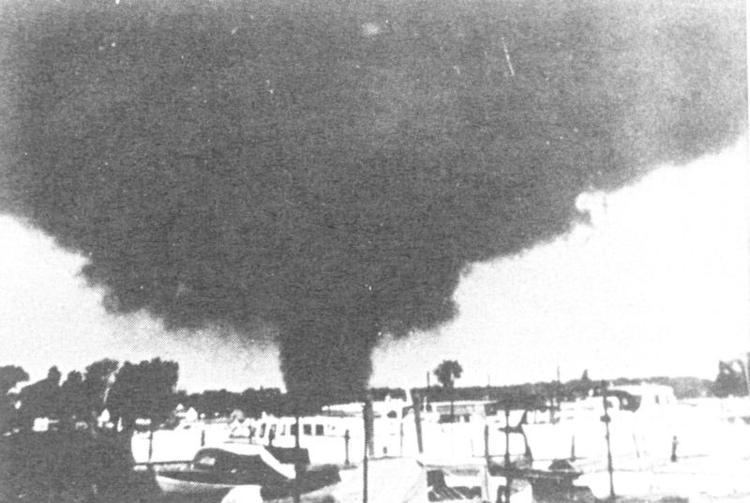 | ||
Formed June 8, 1953, 8:30 pm EST (UTC−01:30) Casualties 116 fatalities, 844 injuries Similar 1953 Worcester tornado, Flint–Worcester tornado outbreak, 1899 New Richmond tornado, 1953 Waco tornado outbreak, Great Natchez Tornado | ||
The 1953 Flint-Beecher Tornado occurred on Monday, June 8, 1953, and ranks as one of the top ten single deadliest tornadoes in United States history. Rated as an F5 on the Fujita Scale, the tornado touched down in Genesee County, Michigan, at 8:30 p.m. (01:30 UTC) and continued on a 27-mile (43 km) path causing 116 fatalities, 844 injuries and an estimated $19 million (1953 USD) in damage. Most of the casualties and damage occurred in the unincorporated community of Beecher, a suburb on the northern edge of the city of Flint, Michigan. The tornado was one of eight tornadoes that touched down the same day in eastern lower Michigan and northwest Ohio. It was also part of the larger Flint–Worcester tornado outbreak of severe weather that began over Nebraska and Iowa, before moving east across the upper Great Lakes states and Ontario, and on to New York and New England causing more deadly tornadoes.
Contents
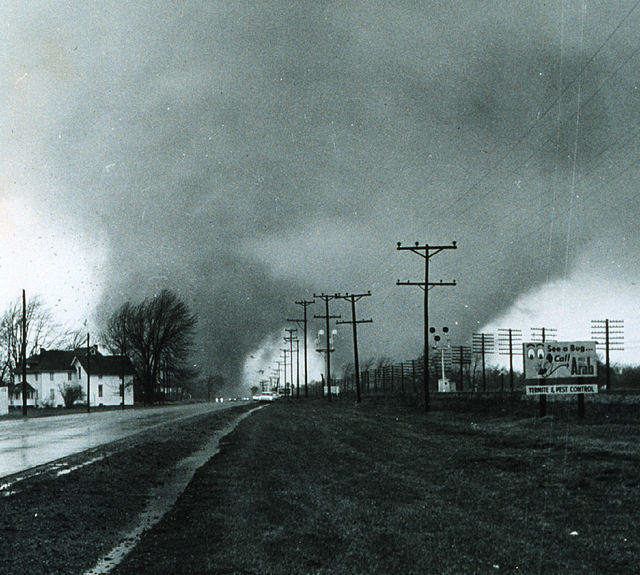
Event
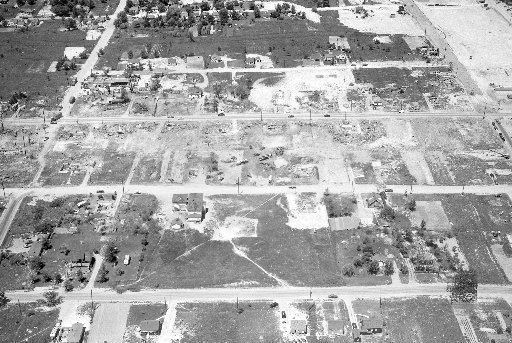
Just prior to the tornado touching down eyewitness accounts recalled that an approaching thunderstorm with several intense lightning strikes turned the northwest sky a dark “black-yellow-green” color. The US Weather Bureau (predecessor of today's National Weather Service) observations that evening recorded a temperature of 78 °F (25.5 °C) with a dew point of 71 °F (21.6 °C) and a barometric pressure reading that fell to 28.89 inHg (inches of mercury) (978.32 mb). Surface map analysis showed a frontal system associated with a strong low pressure moving west across lower Michigan. At 7:30pm (00:30 UTC) the Weather Bureau’s Severe Storms Unit issued a Severe Weather Bulletin alerting of the threat of hazardous weather for southeast lower Michigan.
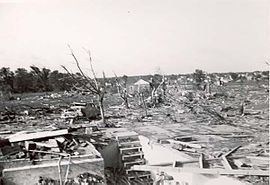
At approximately 8:30 p.m. the tornado touched down in Mt. Morris Township north of Flushing near the intersection of Webster and Coldwater Roads. The first reported observation from the Weather Bureau’s Flint station came just minutes after the tornado touched down, "…unconfirmed Tornado reported 2 mi N Flushing heading ENE possibly hitting Flint 2033 E.” It began to take a path directly east down the Coldwater Road corridor entering the residential neighborhoods of the Beecher district, a Flint suburb. Moving at approximately 35 mph (56.3 km/h) the tornado cut a path 833 yards (761.69 m) wide. At a time before severe storm and tornado warnings the residents of Beecher had almost no advanced warning other than by sighting the tornado heading towards them. Victims recalled hearing the incredible roar from the tornado and seeing its black funnel before heading for shelter in home basements. The densely populated Beecher neighborhoods took a direct hit with several single family houses being completely destroyed. Witnesses recalled that the tornado’s massive funnel resembled black smoke and was accompanied by smaller multiple vortices. Others reported seeing fireballs within the debris of the tornado. Beecher High School was heavily damaged as it was also directly hit by the tornado. The tornado’s path also came close to the North Flint Drive-in theater. Patrons evacuated the drive-in in their vehicles. Some got into vehicle crashes in the ensuing panic to flee while others inadvertently drove into the path of the tornado after leaving the theater. The theater itself received only minor damage.
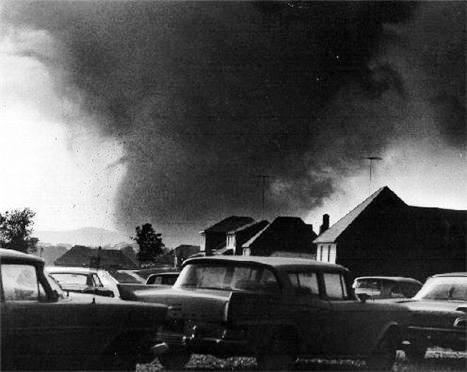
After leaving Beecher the tornado took an east-northeast path following just south of the Flint River where it ravaged farms causing more casualties and destruction near the rural communities of Genesee, Richfield Center and Columbiaville. The tornado stayed on the ground for 27 miles (43 km) and finally dissipated north of Lapeer near Five Lakes Road in Lapeer County’s Deerfield Township. Within minutes a second tornado formed near where the original Flint-Beecher Tornado left the ground. That tornado reached F4 wind speeds and continued east through rural farm lands in Lapeer and St. Clair Counties causing more injuries and damage before moving out over Lake Huron.
Aftermath
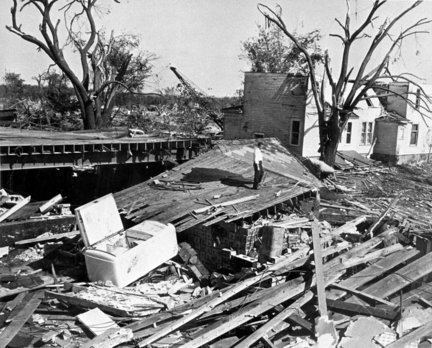
While most of the tornado’s 27 mile path went through rural farmland, most of the devastation was concentrated in the Beecher district. 113 of the 116 fatalities from the tornado occurred in Beecher. Multiple deaths occurred in 20 families and the victims ranged in age from 5 months to 80 years old. Eight area hospitals, including three in Saginaw, were involved in treating victims. Some accounts recalled employees of Flint’s automobile industry leaving factories to head to the site to discover whether or not their families had survived. Large sections of neighborhoods were completely blown away, with only building foundations left. Nearly every home in the Coldwater Road corridor between Clio Road and Dort Highway including the adjacent Kurtz Avenue was destroyed, most of which were swept completely away. The tornado’s force left huge trees debarked or ripped from the ground and vehicles thrown and mangled. Aerial surveys revealed intense helical ground scouring marks in rural areas. In all 340 homes were destroyed and 260 homes were damaged. Another 66 farm and commercial buildings were destroyed or damaged.

A monument was erected with the names of the victims in Beecher at Coldwater Road and Saginaw St near Beecher High School. The tornado remains the single deadliest tornado to occur in Michigan. It remained the deadliest single tornado in modern records (beginning in 1950) until it was surpassed by the Joplin, Missouri, tornado on May 22, 2011. The last F5 tornado in Michigan was the Hudsonville-Standale tornado of April 3, 1956. It was debated in the U.S. Congress at the time whether recent atomic bomb testing in the upper atmosphere had caused tornadoes including this one. Congressman James E. Van Zandt (R-Penn.) was among several members of Congress who expressed their belief that the June 4th bomb testing created the tornadoes, which occurred far outside the traditional tornado alley. They demanded a response from the government. Meteorologists quickly dispelled such an assertion, and Congressman Van Zandt later retracted his statement.
Confirmed tornadoes
This chart shows the number of tornadoes spawned from the initial storm system.
1953 tornado season in perspective
The year 1953 saw some of the deadliest tornadoes in U.S. history, including the Waco Tornado that hit on May 11, the Flint tornado of June 8, and the Worcester tornado on June 9. These 3 storms were also unique in occurring within a 30-day period.
Other severe tornadoes of 1953 hit Warner Robins, Georgia, in April, San Angelo, Texas, in May (same day as Waco), Port Huron, Michigan, also in May, Cleveland in June (same day as Flint), and Vicksburg, Mississippi, in December. There was also an F4 which touched down in Smith Creek Michigan on May 29, 1953, traveled East crossing the St. Clair River and leveled downtown Sarnia Ontario. this storm took 6 lives and caused over 5 million dollars in damage.
